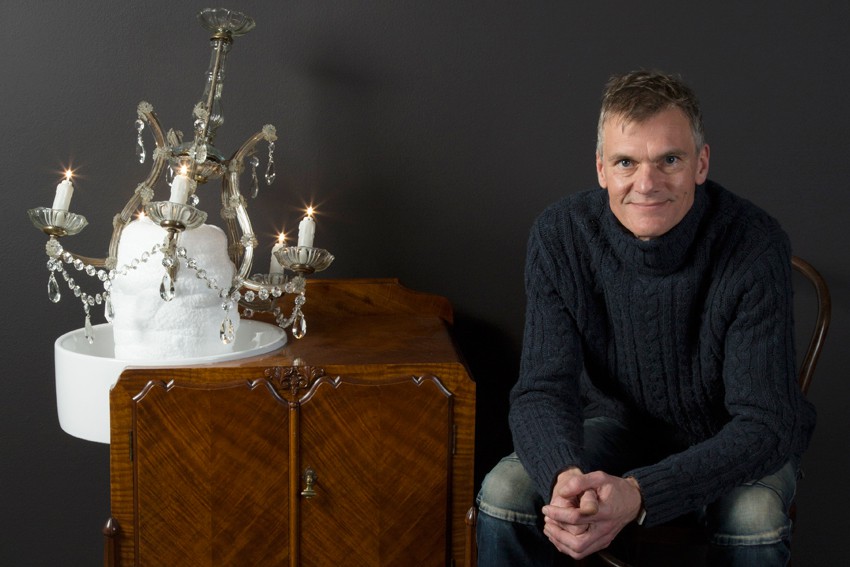SALA: Nicholas Folland

If you are yet to encounter the work of Adelaide artist Nicholas Folland, that’s about to change. Not only is he the subject of this year’s South Australian Living Artists (SALA) monograph (published by Wakefield Press) but his work also features in three SALA exhibitions to coincide with the publication’s release.
If you are yet to encounter the work of Adelaide artist Nicholas Folland, that’s about to change. Not only is he the subject of this year’s South Australian Living Artists (SALA) monograph (published by Wakefield Press) but his work also features in three SALA exhibitions to coincide with the publication’s release. Folland likes to collect things and is drawn to materials and objects that are instilled with history. He manipulates and reconfigures these often-familiar objects and draws on the audience’s association with them. It’s this connection, and how these objects might ignite something from our past, that interests Folland. “A lot of the cut crystal I use is essentially quite kitsch and archaic stuff, but certainly for my parents’ generation it was a classic wedding gift,” he explains. While these pieces were often kept at the back of the cupboard and rarely taken out, they were never thrown away. In works such as Floe and Jump Up, he combines expensive crystal with cheap glassware. “I like the kind of democracy that is set up once you begin to put things together like that. The other thing I am aware of is that, because people have associations with the material, they tend to see the work on a number of levels.” In other works, where Folland uses items of furniture, it’s furniture that aspires to be antique rather than the genuine pieces. “It might have a thin veneer of an expensive material but it is essentially a cheaper production and there is something I like about that mass production that works very well with the kind of mass of materials I tend to clump together.”  The survey show at the Art Gallery of South Australia, particularly, highlights Folland’s interest in exploration and discovery, and contextualises the works by exhibiting them alongside other works from the AGSA’s colonial collection. “A lot of my work deals with early narratives of Australian exploration or discovery but also has some links back to my own family’s history coming across to Australia,” explains Folland, whose ancestors arrived at Holdfast Bay in Adelaide in 1839. Works like Doldrum, a boat filled with crystal and glassware, and Rose, a model ship in a perfume bottle, make reference to maritime encounters. Folland: “Narratives of early exploration have often inspired my works, a lot of my boats in bottles are about boats that have gotten lost on journeys in and around Australia.” Other works in the exhibition reference the expeditions of early explorers into the centre of Australia who battled extreme heat and isolation. In the work Mount Hopeless, which consists of heated granite boulders, Folland encapsulates the despair felt by Edward John Eyre when he abandoned his expedition and named the stony rise in the Flinders Ranges. There are also a number of works that deal with polar exploration and the climatic circumstances of the glacial environment. Whether they are explorations on the sea, land or ice, Folland is interested in the expectations and disappointments that are associated with these journeys. “There is a lot of tragedy in those stories and something that interests me is the fine line between success and failure and the vulnerability of people going through new encounters. The more I travel the more I become interested in those narratives and the history of travel.” The Extreme Climate of Nicholas Folland Art Gallery of South Australia Continues until Sunday, November 30 The Microscope Project Flinders University City Gallery Continues until Sunday, September 21 Touch and Go Greenaway Gallery Continues until Sunday, August 31 nicholasfolland.com.au
The survey show at the Art Gallery of South Australia, particularly, highlights Folland’s interest in exploration and discovery, and contextualises the works by exhibiting them alongside other works from the AGSA’s colonial collection. “A lot of my work deals with early narratives of Australian exploration or discovery but also has some links back to my own family’s history coming across to Australia,” explains Folland, whose ancestors arrived at Holdfast Bay in Adelaide in 1839. Works like Doldrum, a boat filled with crystal and glassware, and Rose, a model ship in a perfume bottle, make reference to maritime encounters. Folland: “Narratives of early exploration have often inspired my works, a lot of my boats in bottles are about boats that have gotten lost on journeys in and around Australia.” Other works in the exhibition reference the expeditions of early explorers into the centre of Australia who battled extreme heat and isolation. In the work Mount Hopeless, which consists of heated granite boulders, Folland encapsulates the despair felt by Edward John Eyre when he abandoned his expedition and named the stony rise in the Flinders Ranges. There are also a number of works that deal with polar exploration and the climatic circumstances of the glacial environment. Whether they are explorations on the sea, land or ice, Folland is interested in the expectations and disappointments that are associated with these journeys. “There is a lot of tragedy in those stories and something that interests me is the fine line between success and failure and the vulnerability of people going through new encounters. The more I travel the more I become interested in those narratives and the history of travel.” The Extreme Climate of Nicholas Folland Art Gallery of South Australia Continues until Sunday, November 30 The Microscope Project Flinders University City Gallery Continues until Sunday, September 21 Touch and Go Greenaway Gallery Continues until Sunday, August 31 nicholasfolland.com.au